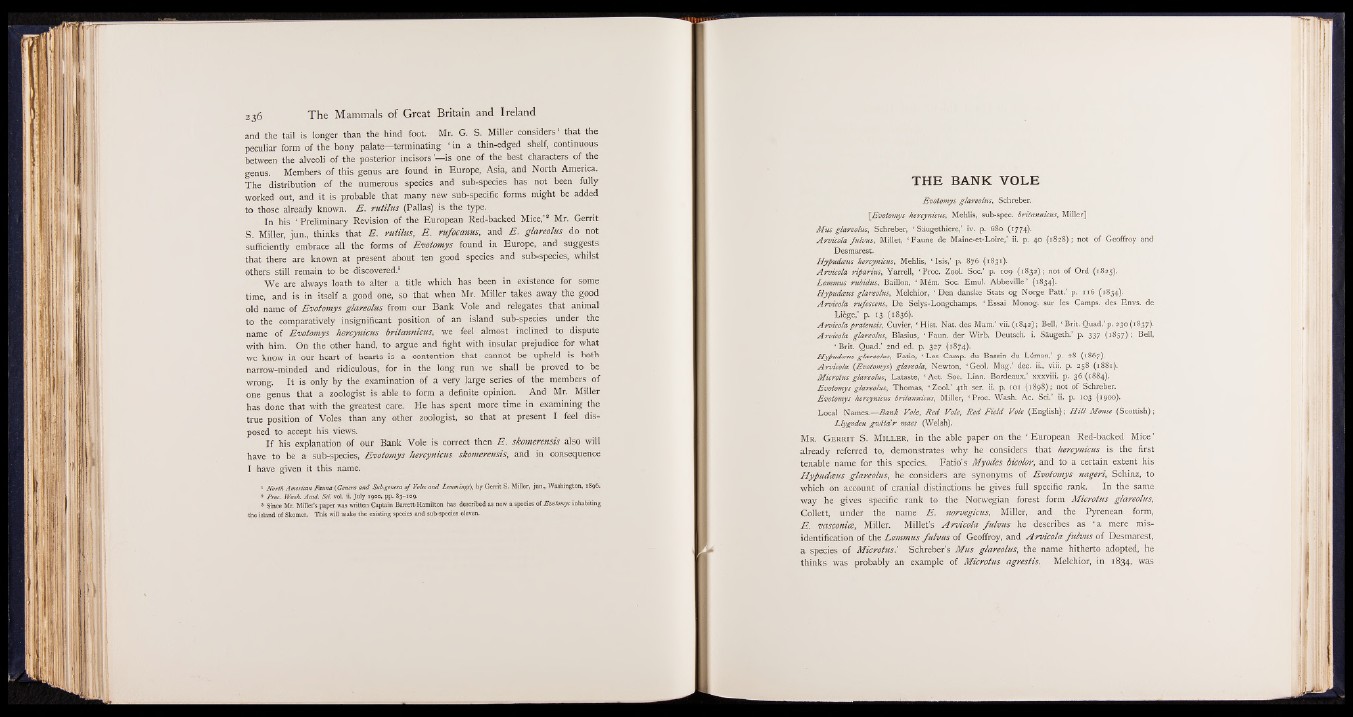
and the tail is longer than the hind foot. Mr. G. S. Miller considers1 that the
peculiar form of the bony palate—terminating ‘ in a thin-edged shelf, continuous
between the alveoli of the posterior incisors ’—is one of the best characters of the
genus. Members of this genus are found in Europe, Asia, and North America.
The distribution of the numerous species and sub-species has not been fully
worked out, and it is* probable that many new sub-specific forms might be added
to those already known. E . ru tilu s (Pallas) is the type.
In his ' Preliminary Revision of the European Red-backed Mice,” Mr. Gerrit
S . Miller, jun., thinks that E . rutilus, E . rufocanus, and E . glareolus do not
sufficiently embrace alf/ithe forms of Evotomys found in Europe, and suggests
that there are known at present about ten good species and sub-species, whilst
others still remain to be discovered.8
We are always loath to alter a title which has been in existeng| for some
time, and is in itself a good one, so that when Mr. Miller takes away the good
old name of Evotomys glareolus from our Bank Vole and relegates that animal
to the comparatively insignificant position of an island sub-species under the
name of Evotomys hercynicus britannicus, we feel almost ., inclined to dispute
with him. On the other hand, to argue and fight with insular prejudge for what
we know in our heart of hearts is a contention that cannot be upheld is both
narrow-minded and ridiculous, for in the long run we shall be proved to be
wrong. It is only by the examination of a very large series of the members of
one genus that a zoologist is able to form a definite opinion. And Mr. Milfe?
has done that with the greatest care. He has spent more time in examining the
true position of Voles than any other zoologist, so that at present I feel disposed
to accept his views.
I f his explanation of our Bank Vole is correct then E . skomerensis also will
have to be alllib-species, Evotomys hercynicus skomerensis, and in consequence
I have given it this name.
1 North American Fauna (Genera and Sub-genera of Voles and Lemmings), by Gerrit S. Miller, jun., Washington, 1896.
* Proc. Wash. Acad. Set. vol. ii. July 1900, pp. 83-109.
3 since Mr. Miller’s paper was written Captain Barrett-Hamilton has described as new a species of Evotomys inhabiting
the island of Skomer. This will make the existing species and sub-species eleven.
THE BANK VOLE
Evotomys glareolus, Schreber.
[Evotomys hercynicus, Mehlis, sub-spec, britannicus, Miller]
Mus glareolus, Schreber, ‘ Saugethiere,’ iv. p. 680 (1774).
Arvicola fulvus, Millet, ‘ Faune de Maine-et-Loire,’ ii. p. 40 (1828) ; not of Geoffroy and
Desmarest.
Hypudceus hercynicus, Mehlis, ‘ Isis,’ p. 876 (1831).
Arvicola riparius, Yarrell, ‘ Proc. Zool. Soc,’ p. 109 (1832); not of Ord (1825).
Lemmus rubidus, Bâillon, ‘ Mém. Soc. Emul. Abbeville ’ ( 1834).
Hypudceus glareolus, Melchior, ‘ Den danske Stats og Norge Patt.’ p. 1x6 (1834);
Arvicola rufescens, De Selys-Lorigchamps, ‘ Essai Monog. sur les Camps, des Envs. de
Liège,' p. 13 (1836).
Arvicolapratensis. Cuvier, ‘ Hist. Nat. des Mam.’ vii. (1842); Bell, ‘ Brit. Quad.’ p. 230(1837).
Arvicola glareolus, Blasius, ‘ Faun. der Wirb. Deutsch. i. Sàugeth.’ p. 337 (1857) ; Bell,
‘ Brit. Quad.’ 2nd ed. p. 327 (1874).
Hypudceus glareolus, Fatio, ‘ Les Camp, du Bassin du Léman,’ p. 28 (1867).
Arvicola (Evotomys) glareola, Newton, ‘ Geol. Mag.’ dec. ii., viii. p. 258 (1881).
Microtus glareolus, Lataste, ‘ Act. Soc. Linn. Bordeaux,’ xxxviii. p. 36(1884).
Evotomys glareolus, Thomas, ‘ Zool.’ 4th ser. ii. p. 101 (1898); not of Schreber.
Evotomys hercynicus britannicus, Miller, - Proc. Wash. Ac. Sci.’ ii. p. 103 (1900).
Local Names.—Bank Vole, Red Vole, Red Field Vole (English) ; H ill Mouse (Scottish) ;
Llygoden gwtta'r maes (Welsh).
Mr. Gerrit S. Mil l er , in the able paper on the ‘ European Red-backed Mice ’
already referred to, demonstrates why he considers that hercynicus is the first
tenable name for this species. Fatio’s Myodes bicolor, and to a certain extent his
Hypudceus glareolus, he considers are synonyms of Evotomys nageri, Schinz, to
which on account of cranial distinctions he gives full specific rank. In the same
way he gives specific rank to the Norwegian forest form Microtus glareolus,
Collett, under the name E . norvégiens, Miller, and the Pyrenean form,
E . vasconice, Miller. Millet’s A rvico la fu lv u s he describes as ‘ a mere mis-
identification of the Lemmus fu lv u s of Geoffroy, and A rvico la fu lvu s of Desmarest,
a species of M icrotus.' Schreber’s Mus glareolus, the name hitherto adopted, he
thinks was probably an example of Microtus agrestis. Melchior, in 1834, was